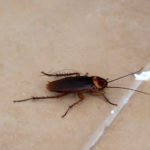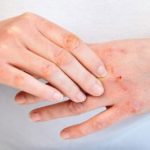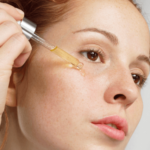
1. Manifestations of dermatitis due to contact with ants
Typically, dermatitis caused by contact with three compartment ants appears on exposed skin areas such as the neck, face, back, hands, and feet. The severity of the inflammation varies depending on the amount of poison that penetrates the skin.
Initially, patients may experience mild itching and tightness, followed by redness in the affected area. After 6-12 hours, red streaks can appear, accompanied by large and small irregular blisters ranging from 1 to 5mm. Within 1 to 3 days, the blisters may become filled with fluid or pus.
During this time, the pain and burning sensation may intensify. Some patients may also experience fever, malaise, and swollen lymph nodes in the neck, armpits, and groin corresponding to the affected area.

If the poison is transferred to the eyes by rubbing or touching them with contaminated hands, it can cause irritation and swelling. In the groin area, the inguinal lymph nodes may become swollen and painful, making walking difficult.
If left untreated, the skin inflammation can progress to an ulcer. The appearance of the sores can vary depending on how the ants were manipulated on the skin.
In some cases, only red spots and small itchy blisters may appear, which subside after 3-5 days without developing burns.
2. Tips for dealing with three-compartment ants
If you come into contact with three-chambered ants, it is recommended to:
- Eliminate the ants without using bare hands to catch, kill, or crush them.
- Wash the exposed areas with soap and water, followed by the application of a mild antiseptic.
- If the affected area develops pus, use a methylene blue solution to disinfect the wound and prevent infection.
- When the wound is dry and no longer draining, it is advised to use antibiotic and bactericidal ointments containing mild and moderate corticosteroids to aid in the healing process.

If blisters develop, the appropriate treatment will depend on the extent of the injury and may involve the prescription of specific medications. Mild cases may only require the use of antiseptics, as the condition is usually self-limiting. However, moderate to severe cases may necessitate the application of skin softeners, topical corticosteroids, oral antihistamines, and antibiotics if signs of superinfection are present.
3. Ways to avoid ant stings
- Prevent insects from entering the house by minimizing excessive door openings, especially near trees and fields.
- Avoid standing under bright lights in public places and take caution when working under lights, as three-cavity ants are commonly attracted to bright lights.
- Vigorously shake towels and clothes before use to remove any hidden ants.
- Do not attempt to catch, kill, or crush three-chambered ants with bare hands.
- If you start to experience burning on the skin, wash the affected area with diluted salt water or soap.

Learn how to prevent and handle ant stings to protect your family today!






































